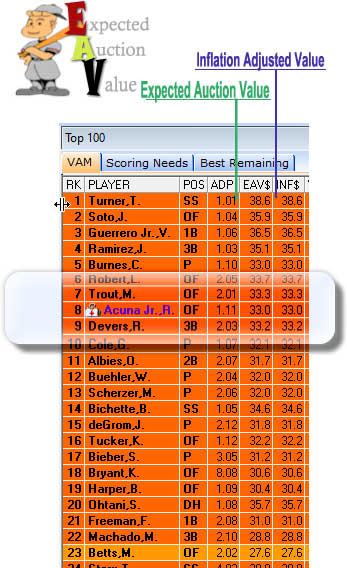The Typical Bidding Draft -
In this type of bidding environment, most of the top players are sold
at reasonable or full projection valuation, which leads to the typical
amount of bargains in the middle and late stages of the draft. This
type of bidding is most typical in private leagues that are managed by
seasoned GMs.
The Conservative Bidding Draft - In this type of bidding environment,
most of the top players are sold at a discount, as a good number of
GM's are looking for bargains. This typically leads to the
bargains in early portion of the draft as top players (top 5%) are
selling at a discount greater than 10-15%. This leads to higher than
expected winning bids on the mid to late round players.
The Aggressive Bidding Draft -
In this type of bidding environment,
most of the top players are sold at a premium as an assertive majority of
GM's are infatuated with the top players. This typically leads to
bargains in the latter portion of the draft as early mid quality players
are selling at a discount greater than expected. This also leads to lower
than expected winning bids on the mid and late round players due
to the money drain on the top players.
What type of auction will you be
in this year? If you have a history with the same GMs, what has your
auction been like in the past? If you have last year's auction draft
info, then it's a good idea to look back and see how your league typically bids.
The good news is that none of the three EAV options will be
dramatically different (only a 10-15% difference for a mid tier player.)
Using this tool, you should be able to conceptually find bargains based on the computed fantasy $ valuation, the
Expected Fantasy Auction Value and the current bidding level.
To illustrate our concept, below is screenshot from the projections software showing the Expected Fantasy Auction Value
and the Inflation Adjusted calculation side by side:

Depending on your
league setup, some players offer additional value based on the
uneven distribution of auction $ spent
during a typical draft. This difference is called Inflation
(INF$)
This is technique is applied to account for players
who were “keep or protected” in keeper leagues at values below Fair
Market Value ($EAV) or where drafted below their expected auction
value. In theory this means that the remaining
players, especially the top players remaining to be drafted, will
increase in auction value. The purpose is to increase the EAV$ of
the top players while maintaining the same budget.
As a formula, Draft Inflation is: ((Original League Budget)-(Frozen
prices of all kept Players))/((Original League Budget)-(Fair Market
Value of kept Players)).
Middle tier
players are often discounted in an un-linear distribution (unevenly) during a live auction, EAV
attempts to estimate what this value will be for each player. Using EAV with the
Linear Player Valuation ( $ ), you can spot the players that offer
value in the later phase of your draft and what you can expect to
pay for them.
More thoughts and suggestions:
Mid tier players typically sell for more than
expected when nominated early during a draft. Resist the urge. As an example: Someone nominates
Player X very early in the draft. You look at his
projected year end $ value on our software (lets say $27), his
Expected Fantasy Auction Value shows $19, he's currently auctioning at $24.
Obviously he's trading for a premium, which will mean that other
players in his neighborhood (offensively) could be had at a possible
discount at some point in the draft. Unless you have a strong
conviction, it's probably wise to let him go.
Top tier players typically sell for a discount during the
middle to late stages of a draft, which is sometimes a great situation
for those who have excess funds. As an example: Bryce Harper is not
nominated until the back end of your draft. You look at his
projected year end $ value on our software (lets say $29), his
Expected Auction Value shows $26, bidding is ending at $20.
Obviously he's trading for a discount, if you're in need of a quality
OF and have the excess funds; you have yourself a draft day steal.
Bottom tier players sell at a great discount
when top and mid range players are sold above their expected
levels.
This aggressiveness early in the draft will drive down prices in the
back end, making for great deals. However it's highly improbable to win a
fantasy championship with a team full of bottom tier players, no
matter what the level of value.
One of my draft day strategies prior to draft day is to
conduct a mock draft, selecting the type of players that will fill my
roster with "the best fit" (Maximize output with the best allocation
of dollars...the goal of every Fantasy GM and MLB GM). Of importance is not
necessarily the players, but the type of players that should be
selected to produce the best outcome for my team. If you do mock draft
using the software, our Draft Summary section will account for
both the dollars spent and the accumulation of stats. Using these
stats we'll be able to tell you the total Fantasy Point expectation
for your team if you play in a Fantasy Points League as well as the
Rotisserie ranking expectation of your
team for each of the scoring categories.
Here's to your success on draft day!